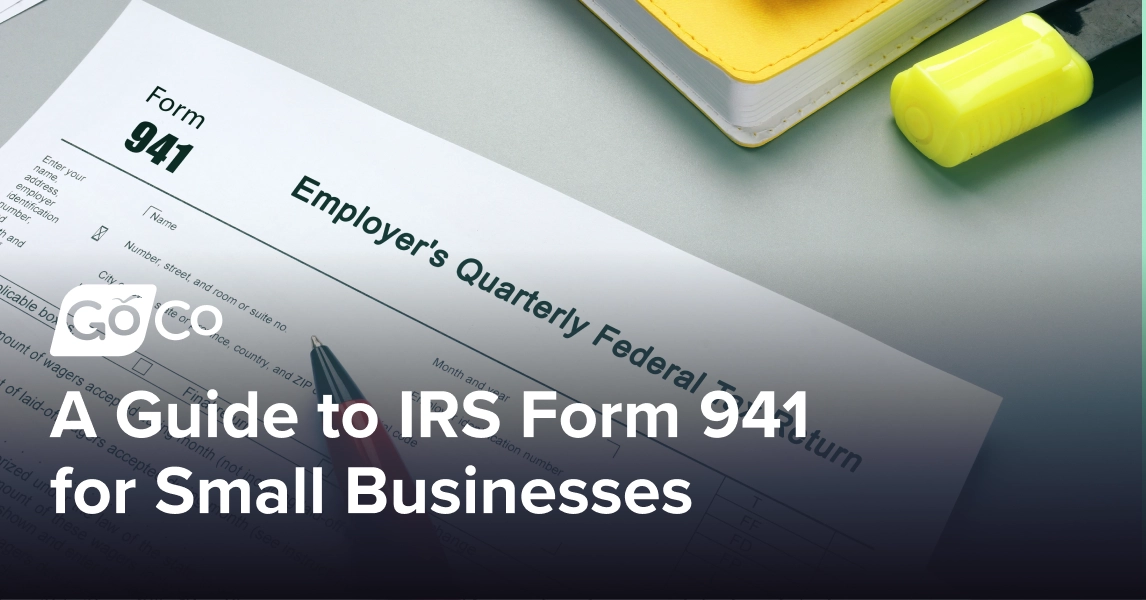A Guide to IRS Form 941 for Small Businesses in 2025
An in-depth look into what Form 941 does, who needs to file it, and how to fill it out.
by Anna Coucke - March 3rd, 2025
While they are definitely not the most exciting thing to think about, calculating payroll taxes are a vital part of running a successful small business. Ensuring you're withholding the correct amount of income tax and Social Security/Medicare contributions (FICA) from your employees' wages, and then remitting those funds to the IRS on time, is crucial for staying compliant and avoiding penalties.
A key player in this process is the IRS Form 941, Employer's Quarterly Federal Tax Return. This form might seem complex at first, but understanding its purpose and how to navigate it will keep your business on the right track.
In this article, we will go over exactly what Form 941 does, who needs to file it, and how to fill it out.
What is IRS Form 941?
Form 941 serves a critical function: it summarizes your company's quarterly federal tax obligations related to your employees' wages.
Here's a breakdown of what it reports:
Federal Income Tax Withholding: This is the portion of income tax deducted from your employees' paychecks based on their W-4 forms.
Social Security and Medicare Taxes (FICA): Both employers and employees contribute to these taxes, which fund Social Security and Medicare benefits. Form 941 reports both the employee and employer portions.
By filing Form 941 quarterly, you're essentially telling the IRS the total amount of income tax you've withheld from your employees' wages, along with the total FICA taxes (both employee and employer contributions) for the quarter. You'll also calculate and report any additional taxes owed based on these figures.
Who Needs to File Form 941?
The majority of businesses that pay employees will need to file Form 941 quarterly. However, there are a few exceptions:
Seasonal Businesses: If your business operates only during specific quarters (e.g., landscaping in the summer), you only need to file Form 941 for those quarters with employees on payroll.
Household Employees: For employees like nannies or maids, you'll typically use Schedule H of Form 1040 instead.
Farm Workers: If you primarily employ farmworkers, you'll likely use Form 943 for reporting their income taxes.
Low Payroll Amounts: Businesses that pay less than $1,000 in total employment tax annually may be eligible to file Form 944 instead (an annual return).
Updates to Form 941 in 2024
The IRS introduced several changes to Form 941 for the 2024 tax year. Here's a summary of the key updates:
Social Security tax rate: Increased to 6.2% for both employers and employees.
Social Security wage base: Increased to $168,600 from $160,200.
Removal of COVID-19-related credits for qualified sick and family leave wages: These credits are no longer available on Form 941 for wages paid in 2024.
Household workers: Subject to Social Security and Medicare taxes if they earn $2,700 or more in 2024.
Election workers: Subject to Social Security and Medicare taxes if they receive $2,300 or more in cash or equivalent compensation in 2024.
Forms 941-SS and 941-PR: As of 2024, these forms for employers in U.S. territories are no longer available. They should instead file the standard Form 941 or the new Form 941 (sp), Declaración del Impuesto Federal Trimestral del Empleador, which has Spanish instructions.
Pubs. 51, 80, and 179: These are no longer available for 2024. Instead, information specific to agricultural employers and employers in U.S. territories will be included in Pub. 15, Employer's Tax Guide. Starting in 2024, there will also be a new Spanish-language version of Pub. 15.
How to Fill Out Form 941
To ensure accurate completion of Form 941, you'll need to have some key pieces of information. Before you begin filling out the form, ensure you have the following readily available:
Employer Identification Number (EIN): This unique number identifies your business for tax purposes.
Payroll Records: This includes your total number of employees paid during the quarter, wages and tips paid to employees, federal income tax withheld from paychecks, and both the employee and employer portions of Social Security and Medicare taxes.
Tax Deposit Records: If you've already made any federal tax deposits throughout the quarter related to payroll taxes, keep a record of the deposit dates and amounts.
Once you have this information at hand, you can begin the filing process. Form 941 itself might seem intimidating at first glance, with multiple sections and calculations. However, by breaking it down into sections, you can approach it more systematically.
Here's a simplified overview of the main parts of the form and what they are asking for:
Questions About Your Business for the Quarter: This section gathers basic information like your business name, EIN, and address.
.png)
Part 1: Your Tax Liability for the Quarter
Here, you'll report the total wages and tips paid, federal income tax withheld, and both employee and employer portions of FICA taxes. You'll also calculate any additional taxes owed and determine your total tax liability for the quarter..png)
Part 2: Details About Quarterly Tax Liability
This section asks you to break down your tax liability for each month of the quarter.
.png)
Part 3: Details About Your Business
This section is only used for specific situations, such as if your business closed or is seasonal.
.png)
Part 4: Details of Your Third-Party Designee (Optional)
If you're using a payroll service or tax professional to file Form 941 on your behalf, you'll enter their information here.
.png)
If you need more assistance with filling out Form 941, you can find detailed instructions on the IRS website.
Filing Deadlines and Late Penalties for Form 941
Unless they fall into one of the exceptions mentioned earlier, all employers must file Form 941 every quarter. The due dates typically fall on the last day of the month following the end of the quarter. If any due date falls on a Saturday, Sunday, or legal holiday, returns are due on the next business day.
The current filing deadlines for Form 941 are as follows:
April 30 (For the quarter ending March 31)
July 31 (For the quarter ending June 30)
October 31 (For the quarter ending September 30)
January 31 of the next year (For the quarter ending December 31)
Failing to file Form 941 by each deadline or underreporting your tax liability can result in IRS penalties, which can amount to 5% of the total tax amount due. For each month your return has not been submitted, you can be charged an additional 5% fee for up to 5 months, which can equate to a total of up to 25% of your total tax amount due.
If you discover an error on a previously filed Form 941 or need to amend a Form 941, a Form 941-X, Adjusted Employer's Quarterly Federal Tax Return or Claim for Refund must be filed separately.
Additional Tips for Streamlining Form 941 Filing
The penalties for Form 941 errors can be costly and stressful, so it is vital that you have processes established for keeping track of payroll and other critical information.
Here are some ways to ensure you stay compliant:
Develop a System: Establish a clear and organized process for gathering and storing payroll tax information throughout the quarter. This will make completing Form 941 a smoother experience and reduce the likelihood of missing information or making mistakes.
Consider Payroll Software: Payroll software can automate many aspects of payroll processing, including calculating and withholding taxes automatically. This can save you time and minimize the risk of errors.
Stay Informed: Payroll tax regulations can change periodically. Stay updated on any relevant changes to ensure your business remains compliant. The IRS website is a valuable resource for staying informed.
By familiarizing yourself with Form 941, utilizing the available resources, and coming up with a system to make the process more seamless, you can ensure your business stays compliant with payroll tax regulations.
Remember, timely and accurate filing of Form 941 is essential for avoiding penalties and maintaining a good standing with the IRS, which contributes to the smooth operation and overall financial health of your small business.
How GoCo Streamlines Payroll
Payroll management is undeniably a stressful and complex aspect of HR administration, especially regarding compliance. Mistakes can have serious implications, leading to demoralized staff and potential fines from government entities.
GoCo's embedded payroll software automatically keeps up with compliance changes, automates tax calculations and filing, and allows you to run payroll seamlessly. Our payroll grid automatically flags errors and missing information so your payroll is processed accurately, and tax and benefits withholdings for employees are calculated and handled automatically for you – giving you peace of mind each pay period.
Want to see how GoCo can streamline your payroll, compliance, and much more? Take a free interactive tour of our platform today!
FAQs
-
Form 941 is the Employer's Quarterly Federal Tax Return used to report income taxes and payroll taxes withheld from employee wages, as well as the employer's share of Social Security and Medicare taxes.
-
Most businesses that pay wages to employees must file Form 941 quarterly. However, there are exceptions for certain types of businesses and employees, such as seasonal businesses, household employees, farm workers, and businesses that pay less than $1,000 in total annual employment tax.
-
Form 941 is filed quarterly, and falls at the end of the month following the end of each quarter. The deadlines are April 30th, July 31st, October 31st, and January 31st.
-
You'll need your Employer Identification Number (EIN), payroll records, tax deposit records, and information about your employees' wages, tips, and federal income tax withheld.
-
Late filing of Form 941 can result in penalties of 5% of the unpaid tax for each month the return is late, up to a maximum of 25%.
-
If you discover an error on a previously filed Form 941, you need to file a Form 941-X, Adjusted Employer's Quarterly Federal Tax Return or Claim for Refund.
-
Yes, you can e-file Form 941. This is often the faster and more secure method of filing.
Updated 3/3/2025

Subscribe to Beyond The Desk to get insights, important dates, and a healthy dose of HR fun straight to your inbox.
Subscribe hereRecommended Posts
Leveraging the Power of HR Automation
Blog Articles
HR's Guide to Employee Record Retention [+Checklist]
Blog Articles
Search...
Product
GoCo
Resources
Articles
eBooks
Webinars
Customer Stories






